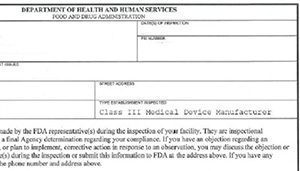Kristen Grumet, NSF International
There are many reasons medical device manufacturers receive warning letters from the U.S. FDA: Failing to maintain proper documentation, overlooking or not completely investigating customer complaints, incomplete corrective and preventive action (CAPA) files, poor design controls.
It’s often, at least partially, because the manufacturers weren’t prepared to respond to observations cited on the FDA Form 483s as quickly and thoroughly as required.
In 2015, the FDA conducted 1,484 quality system surveillance medical device inspections in the U.S., with just more than half of them of them resulting in the issuance of a Form FDA 483 (commonly referred to as a 483), according to the agency’s 2015 Annual FDA. Medical Device Quality System Data report. Upon receiving the dreaded 483, medical device manufacturers have just 15 business days to respond in a manner that fully addresses the inspection findings, evaluates the root causes and identifies short- and long-term corrective actions with realistic milestones and timelines. It’s a challenging demand and an area in which many manufacturers fall short.
The FDA issued 121 warning letters to medical device manufacturers for violations of the Quality System Regulation in 2015. The most often-cited violations include deficiencies related to production and process controls (P&PC) and CAPA. Warning letters often included language stating that a previous 483 response was found to be deficient in some way.
Do you know what to do if an FDA inspection of your facility results in a 483? What if a warning letter shows up on your desk? If not properly addressed, warning letters can lead to significant penalties, injunctions and importation bans.
Although every situation is different, the following steps are almost always appropriate when facing FDA scrutiny and potential regulatory action:
Step No. 1: Minimize the damage
While it is always prudent to address identified deficiencies as soon as possible during an FDA inspection, the close-out meeting at the end of the inspection can be crucial to minimizing the damage that can come from a poor showing during the inspection. If the FDA investigator observed objectionable conditions at your facility, this is when he or she will present the findings to your senior management team by issuing a 483.
Take time to listen. Use this close-out meeting to fully understand the intent and scope of the investigator’s observations. Ask for clarifications when needed, but remember that everything you say is likely to be included in the Establishment Inspection Report (EIR). You should correct any misperceptions or inaccuracies and be prepared to provide evidence to support your claims. Only observations you can demonstrate as factually incorrect are likely to be modified or removed from the 483.
Step No. 2: Take the inspection process seriously
When the FDA sends an investigator to your facility — sometimes for days, weeks or even months at a time — the agency is making a significant investment to evaluate your company’s quality system compliance. Be sure to take the inspection process seriously and give it the preparation and attention it deserves.
Identify the internal and external resources you’ll need to prepare for and manage the FDA inspection. Make sure you’re ready by assigning inspectional front room roles and responsibilities at your facility, including hosts, runners, subject-matter experts and scribes. Demonstrate professional respect and engagement by including senior leaders in the inspection’s opening and close-out meetings. Set up a back room to facilitate quick retrieval and review of documents requested during the inspection. Train all employees on inspectional behaviors and protocol, as there is the potential for any employee to be called upon during an inspection. If needed, engage a consultant with experience in medical device quality system improvement and remediation to help you prepare for the possibility of an inspection or respond to a 483. Remember, your organization will have just 15 days to respond and fully address the inspectional observations.
Step No. 3: Cooperate with FDA investigators
Arguing with the FDA is never a good idea – not during the inspection, the close-out meeting or in your written response. Listen carefully and review the 483 observations thoroughly before you try to defend your position. Ask questions if you need more information. FDA investigators often have a broader perspective on issues based on their experience, and it may take a while to fully understand their concerns.
If you have fully digested the FDA’s observations and you disagree with the findings, respectfully explain your concerns and provide objective evidence to support your position. If necessary, request a separate meeting with the FDA district office to discuss the specific observations further. If you are unsuccessful in explaining your position during the inspection or follow-up meeting, don’t use the same rationale in your written response and expect to receive a different reaction.
Correct as much as possible in the first 15 business days and provide realistic, but responsive, completion timelines for longer-term corrective actions. The FDA understands that it’s not always possible to complete corrective actions in just 15 days, but a detailed response with reasonable milestones and completion timeframes will demonstrate that you are cooperating and are committed to addressing the identified deficiencies.
Step No. 4: Provide evidence of your actions
Failing to provide objective evidence may be the most common inadequacy of unsuccessful 483 responses. You may have revised the appropriate procedures, conducted training and performed retrospective reviews, but the FDA will not take your word for any of it. If you don’t document your actions and provide the documentation with your response, the FDA may conclude you didn’t do it.
Provide evidence of completed corrections and corrective actions in your response, including updated procedures, training records, CAPA plans and reports. The same holds true if you must argue an FDA observation. You will need to provide objective evidence that an inspection finding is factually incorrect for the FDA to reconsider an observation.
Step No. 5: Focus on the details
When responding to a 483 or a warning letter, your response should be comprehensive and address all observations or violations. Be sure to address the specific examples noted in 483 observations. Many manufacturers focus so much on addressing the root cause of the issue that the specific examples are overlooked.
When revising or creating procedures, it’s important to fully understand the FDA’s definition of “establish.” According to 21 CFR 820.3(k), “establish means define, document (in writing or electronically) and implement.” New procedures are not “implemented” until the standard operating procedures (SOPs) have been approved and made effective, and training has been completed. When submitting new or revised procedures, FDA expects you to include evidence of training in your response package.
Step No. 6: Look beyond the details
While it’s important to address specific examples of non-compliance, don’t overlook the larger quality system glitches that may have allowed the non-compliance in the first place. The “Band-Aid approach” doesn’t work. Look beyond the immediate issue to anticipate where similar non-compliance issues could occur and take systemic corrective action. You need to understand the root cause of the issue to truly understand its impact on all products. Manufacturers commonly underestimate the breadth or impact of a cited non-compliance.
Just as it’s important to look beyond the immediate issue and take systemic corrective actions, we must also look back and evaluate the impact of long-standing deficiencies on past practices, decisions and records. Consider conducting a retrospective review to identify and remedy past deficiencies. When new or revised procedures result in significant changes to processes or decision-making criteria, a retrospective review may be needed. Two years is generally considered an adequate timeframe for a retrospective review, but a longer duration may be necessary for long-standing or high-risk issues. Be prepared to defend the duration of the retrospective review as well as any sampling plans that are used to analyze the data as part of the response.
Keep all these steps in mind when the FDA comes calling. They may help in your response to 483s and warning letters. The FDA will focus on what’s wrong with your medical device quality system. It’s up to you to determine the best way to fix it.
Kristen Grumet is executive director of quality systems at NSF International – Medical Devices. As a consultant based in San Jose, Calif., she often helps medical device manufacturers after they’ve received 483s or warning letters.








